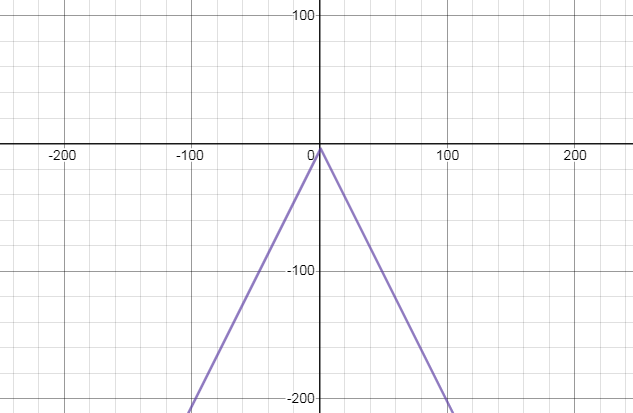
(a)
Find the parent function
(a)
Answer to Problem 39E
For the function
Explanation of Solution
Given information:
Calculation:
Parent function is the basic function of a family of functions that preserves the definitions, shape of its graph and properties of the entire family.
Parent function used in this question is the absolute value function i.e
To identify the parent function, strip all the arithmetic operations on the function to leave behind one higher order operation in just x.
So, remove the arithmetic operation of multiplication by -1 and then addition of 4 to x and addition of 8 to it from the given funcion to get the parent function.
Conclusion:
So,
remove the arithmetic operation of subtractionof 1 from x and multiplication by -2 and then subtraction of o
f 4 from the given funcion to get the parent function.
Find the sequence of transformation from f to g.
Answer to Problem 39E
The shape of is drawn reflected in the x-axis and then shifted right by 1 unit and stretched by 2 units and then shifted downward by 4 units is the required sequence of transformations from
Explanation of Solution
Given information:and
Calculation:
The sequence of transformations from ƒ to g depicts the steps followed and the transformations used to reach from the parent function ƒ to g.
The sequence of transformations from
Types of shifts used in function transfromation:
1. Vertical shift: If
If
2. Horizontal Shift:If
If
3. Reflection:The graph for the function say
The graph for the function say
4. Vertical Stretching and Shrinking:If
If
5. Horizontal Stretching and Shrinking:If
If
The shape of
The sequence of transformations from ƒ to g depicts the steps followed and the transformations used to reach from the parent function ƒ to g.
Conclusion:
The shape of is drawn reflected in the x-axis and then shifted right by 1 unit and stretched by 2 units and then shifted downward by 4 units is the required sequence of transformations from
(c)
To sketch the graph of
(c)
Answer to Problem 39E

Explanation of Solution
Given information:
Calculation: Use the sequence of transformation to plot the graph of the function
Obtain the graph of
(d)
To write
(d)
Answer to Problem 39E
Explanation of Solution
Given information:
Calculation:
Multiply
Chapter 1 Solutions
EBK PRECALCULUS W/LIMITS
- a -> f(x) = f(x) = [x] show that whether f is continuous function or not(by using theorem) Muslim_mathsarrow_forwardUse Green's Theorem to evaluate F. dr, where F = (√+4y, 2x + √√) and C consists of the arc of the curve y = 4x - x² from (0,0) to (4,0) and the line segment from (4,0) to (0,0).arrow_forwardEvaluate F. dr where F(x, y, z) = (2yz cos(xyz), 2xzcos(xyz), 2xy cos(xyz)) and C is the line π 1 1 segment starting at the point (8, ' and ending at the point (3, 2 3'6arrow_forward
- I need help in ensuring that I explain it propleryy in the simplifest way as possiblearrow_forwardI need help making sure that I explain this part accutartly.arrow_forwardPlease help me with this question as I want to know how can I perform the partial fraction decompostion on this alebgric equation to find the time-domain of y(t)arrow_forward
- Please help me with this question as I want to know how can I perform the partial fraction on this alebgric equation to find the time-domain of y(t)arrow_forwardEvaluate F³ - dr where ♬ = (4z, -4y, x), and C' is given by (t) = (sin(t), t, cos(t)), 0≤t≤ñ .arrow_forwardMid-Term Review Find the formula for (f + g)(x). f(x) = x² - 10x + 25 and g(x) = x² - 10x + 24 (f + g) (x) = [ 2 ]x² X + DELL Skip Sarrow_forward
 Calculus: Early TranscendentalsCalculusISBN:9781285741550Author:James StewartPublisher:Cengage Learning
Calculus: Early TranscendentalsCalculusISBN:9781285741550Author:James StewartPublisher:Cengage Learning Thomas' Calculus (14th Edition)CalculusISBN:9780134438986Author:Joel R. Hass, Christopher E. Heil, Maurice D. WeirPublisher:PEARSON
Thomas' Calculus (14th Edition)CalculusISBN:9780134438986Author:Joel R. Hass, Christopher E. Heil, Maurice D. WeirPublisher:PEARSON Calculus: Early Transcendentals (3rd Edition)CalculusISBN:9780134763644Author:William L. Briggs, Lyle Cochran, Bernard Gillett, Eric SchulzPublisher:PEARSON
Calculus: Early Transcendentals (3rd Edition)CalculusISBN:9780134763644Author:William L. Briggs, Lyle Cochran, Bernard Gillett, Eric SchulzPublisher:PEARSON Calculus: Early TranscendentalsCalculusISBN:9781319050740Author:Jon Rogawski, Colin Adams, Robert FranzosaPublisher:W. H. Freeman
Calculus: Early TranscendentalsCalculusISBN:9781319050740Author:Jon Rogawski, Colin Adams, Robert FranzosaPublisher:W. H. Freeman
 Calculus: Early Transcendental FunctionsCalculusISBN:9781337552516Author:Ron Larson, Bruce H. EdwardsPublisher:Cengage Learning
Calculus: Early Transcendental FunctionsCalculusISBN:9781337552516Author:Ron Larson, Bruce H. EdwardsPublisher:Cengage Learning





